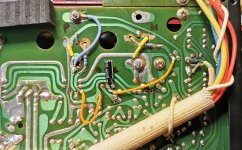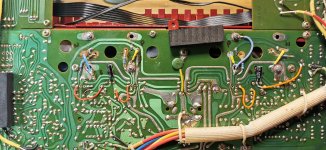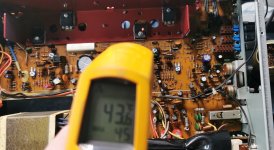Definitely sound like it is going unstable for some reason.
And you are sure the gates go only to the gate resistors. No caps anywhere on the gate side?
Make sure the gate resistors are correct and not out by a factor of 10 by mistake.
Check the 10 ohm Zobel resistor is OK.
It is remotely possible the 1 ohm upsets things. Make sure the cap that goes to the 1 ohm is OK. Perhaps add another across it as a test. Anything. Watch for polarity though.
The small pF value caps are used to set the stability margins but don't go taking them out, its highly unlikely they are faulty.
And you are sure the gates go only to the gate resistors. No caps anywhere on the gate side?
Make sure the gate resistors are correct and not out by a factor of 10 by mistake.
Check the 10 ohm Zobel resistor is OK.
It is remotely possible the 1 ohm upsets things. Make sure the cap that goes to the 1 ohm is OK. Perhaps add another across it as a test. Anything. Watch for polarity though.
The small pF value caps are used to set the stability margins but don't go taking them out, its highly unlikely they are faulty.
That should be fine. They are very very uncritical, anything from a couple of hundred ohms upwards should work. At DC even a few meg ohms would be OK. They work by forming a low pass filter when combined with the gate capacitance of the FET and are necessary for stability.
So before turn on drivers installed but amp turned off
Pre sets -set to 2k
on board reading -2k
Drivers removed amp turned off
Pre sets across read 655 ohms
Turn on initialy
no lamp on
centres read 0v
current is ,without adustment 0.5mv across 1 ohm
same for both channels
not gone any further as yet
Pre sets -set to 2k
on board reading -2k
Drivers removed amp turned off
Pre sets across read 655 ohms
Turn on initialy
no lamp on
centres read 0v
current is ,without adustment 0.5mv across 1 ohm
same for both channels
not gone any further as yet
Attachments
Well its all sounding promising so far. It will be interesting to see if that sudden jump in current is resolved going driverless.
Laterals need a fairly large Vgs at high current, especially the P channel.
This means that the swing will be limited into 4 Ohm speakers
This means that the swing will be limited into 4 Ohm speakers
so i have exactly 100mv across each 1 ohm now, increase increments are smooth and no noise now at all
my only concern is the regulated supply transistors are quite warm, more than normal at 40c,so we will have to see how this goes once i apply a load and they may need to be upgraded
my only concern is the regulated supply transistors are quite warm, more than normal at 40c,so we will have to see how this goes once i apply a load and they may need to be upgraded
Ok so i have discovered we still have a buzzing noise, but only when switched to the 8ohm setting on the transformer, on the 4ohm setting-nothing
That is the generally accepted point where the negative and positive temperature coefficients coincide. It usually gives the most stable bias current for a given gate source voltage. Experiment, can you hear a difference going lower. Remember lower means cooler and that is always a consideration if heatsinks are smallish.we are looking for about 100ma right?
Ok so i have discovered we still have a buzzing noise, but only when switched to the 8ohm setting on the transformer, on the 4ohm setting-nothing
All the switch does is alter the rail voltage but I've still no real clue as to what is happening. The scope would tell you more such as frequency and amplitude of this noise.
Have you tried with the 1 ohm linked out? (but still with a bulb). Does it still have this noise?
so no noise with the bulb @8ohms
no difference with 1 ohm linked out either with or without lamp
only makes a noise when on full mains @8ohms
could it be the transformer itself?
no difference with 1 ohm linked out either with or without lamp
only makes a noise when on full mains @8ohms
could it be the transformer itself?
I doubt its the transformer because the noise (as I understand it) is on the audio feed to the speaker. Also only one channel affected? So that doesn't suggest a transformer issue.
Careful diagnostics with the scope are the first thing to do. Try and put a name to the noise, is it a low frequency noise or is there lots of high frequency hash there as well. What sort of amplitude?
They are all clues that might help piece it all together.
You also have to try it with shorting plugs in the inputs to the power amp to make absolutely sure its not something getting in from earlier stages.
Careful diagnostics with the scope are the first thing to do. Try and put a name to the noise, is it a low frequency noise or is there lots of high frequency hash there as well. What sort of amplitude?
They are all clues that might help piece it all together.
You also have to try it with shorting plugs in the inputs to the power amp to make absolutely sure its not something getting in from earlier stages.
so after checking again its both channels, one just gets noisier later as you raise the current
ive got 2 others to repair today so once ive finished them ill clear away a bit as i dont have room for the scope on the table along with everything else i have out
roll on getting a proper work space when i move!
roll on getting a proper work space when i move!
- Home
- Amplifiers
- Solid State
- NAD 3130 conversion to Lateral FET


